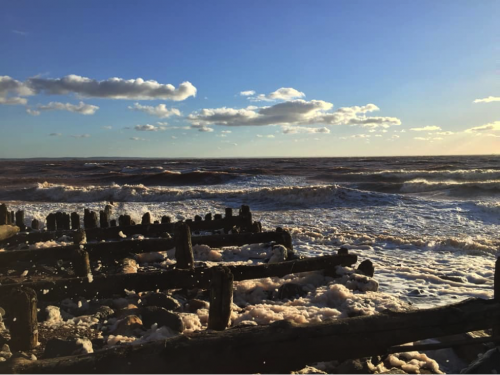Fundy Field Notes - Growing up Fundy
#thoughtsonrocks - Growing up Fundy

A windy day at Carrs Brook beach, and the remains of the old wharf.
I consider myself fortunate to have grown up alongside one of the wonders of the world, but I admit I spent years taking it for granted. The dramatic rise and fall of the tide, red sandstone, glittering gemstones, and daily walks on the ocean floor were part of everyday life in rural Economy, Nova Scotia. It wasn’t until I spent a few years on the West Coast that I realized just how unique the Bay of Fundy is. I’d show photos of the changing tide to fellow students from the mountains or the prairies and watch their amazed expressions.
The tide shaped my childhood as it does the shoreline. Swimming in the ocean was a daily pastime in the summer. If you walk straight onto the ocean floor from the end of the old Carrs Brook wharf, you’ll find my favorite rock. You must understand - this is a fantastic rock and every child in Economy knew it. A lone boulder on the flat ocean floor, it towered over my younger self. Only at low tide would it reveal a tide pool at its base brimming with life: clams deep in the mud that spit at you for picking them up, purple mussels, “Mermaid’s Purses” (shark or skate egg sacs), popping seaweed, clay we used as a sort of sunscreen, and a vast colony of periwinkles going about their slow periwinkle business. I couldn’t wait for the ocean to recede so I could spend hours checking out the tide pool.
The fast-moving and strong tides are a feature of our shore that must be respected, and sometimes folks learn this the hard way – just a few years ago some relatives and I were stunned on our peaceful beach walk to see a large mass moving about on what locals call the “Chimney Rocks” – large sandstone deposits in the middle of the Bay that, at high tide, barely peek out above the surface of the waves. We wondered out loud what the creature might be, tried to zoom on our cameras to see it, and cursed ourselves for forgetting the binoculars. We had our answer shortly as a rescue helicopter approached from the other side of the bay – some unfortunate tourists had tried to race the tide. Instead, they found themselves huddled together on the rocks, surrounded by more water rushing past than all the world’s rivers combined. A lesson learned, I’m sure.
The beaches and cliffs that served as a site of many bonfires and family gatherings are now a source of wonder for different reasons. My beloved Carrs Brook is the site of paleontological discoveries and traditional weir fishing practices adopted by my ancestors from the Mi’kmaq; and Wasson Bluff is no longer just a beautiful view but the source of some of the oldest dinosaur bones in Canada. A visit to Fundy Geological Museum and a day out with our experts weaves together the stories and the science behind the place I call home.
Visit the Fundy Geological Museum to explore the world’s highest tides, Canada’s oldest dinosaurs, & the gorgeous minerals of Nova Scotia! Check out our Facebook, Twitter, & Instagram accounts for behind-the-scenes looks at all the things!
About the author
Marlee Leslie is Fundy Geological Museum’s Marketing Coordinator. Her studies took her from Canada’s east coast to the west coast, and back again. She is passionate about local food and regenerative agriculture, her rural Nova Scotian community, and can usually be found on a horse or behind a camera.